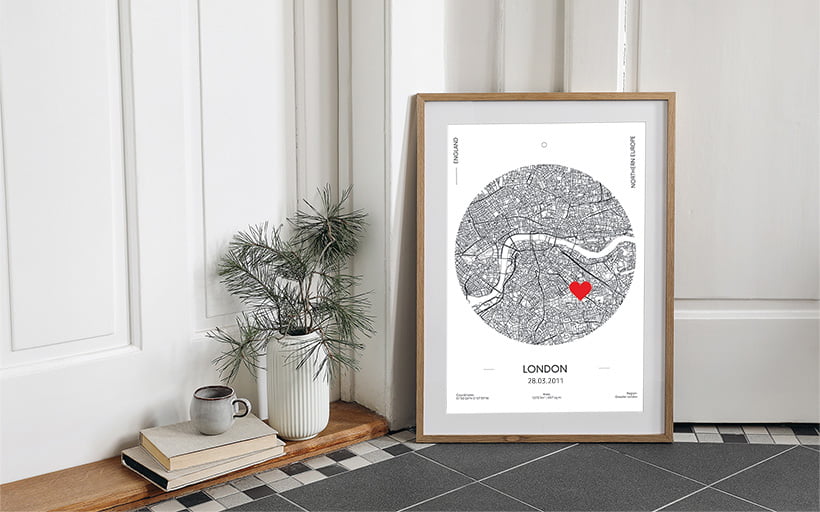How to improve lead generation on your ecommerce site
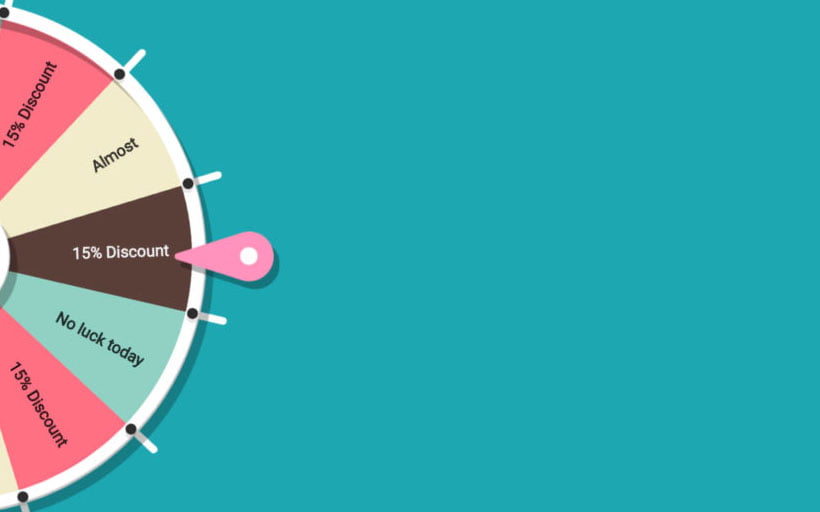
Interested in joining the world's leading print on demand platform?
When it comes to lead generation, there's an adage about as old as online marketing itself, which goes: Traffic is vanity, conversion is sanity.
It's tough to disagree; visitors to your website are great, but traffic alone doesn't pay the bills.
And that's why we need to talk about a certain number. It's a percentage, actually 1.33%.
According to ecommerce benchmarking company Compass, this paltry figure was the average conversion rate for an ecommerce website during Q2 2018.
This means out of every 100 visitors to the average ecommerce store, maybe 1 or 2 of them will convert. What happens to the other 98 or 99? It's unclear.
When you spend so much time (and money) driving traffic to your site, this figure can quickly flip from 'irritating' to 'soul-destroying!'
But you're not alone. This is a common theme across the world of online marketing, and it's a reflection of the fact that the way customers buy products has fundamentally changed.
Across pretty much every niche and industry, customers tend to be far less spontaneous. They do more research, they consider purchases more deeply. The whole process takes longer, and generally takes more touches.
(There's also more competition — which means that if you don't make the sale first time, there's a big chance your customer will end up buying somewhere else.)
And, owing to that extended buying cycle, the idea that 'perseverance pays off' has never been so accurate.
Many — if not most — purchases, are the result of days, weeks, months of prolonged interactions and touch points with the customer.
An important point of clarification: 'conversion' is often used as a byword for 'sales.' But that's not necessarily accurate. Obviously, that's the best type of conversion. But, equally, 'conversion' can refer to taking that anonymous stranger who visits your site, and turning them into a lead by capturing their contact information.
The numbers suggest that your customers will rarely be ready to buy the first time they visit.
But simply snagging your customers' contact information gives you the power to continue your involvement in that sales journey, nurturing and nudging them along the line to a successful conclusion. That, in its purest sense, is lead gen for ecommerce. After all — today's leads are tomorrow's customers!
So, in this article, we'll be showing you a variety of great ways you can start to turn your ecommerce store into a lead gen machine!
Newsletter Signups
One of the most ubiquitous lead gen tools for ecommerce websites is the simple yet powerful newsletter signup. It's an easy win for both parties, because (as we'll show you in just a sec) it's incredibly easy to set-up, but it's also valuable for the visitor. Who wouldn't want to receive news, offers and discounts right to their inbox? They may not be ready to buy now, but they may want you to keep them informed for the future.
To set-up a newsletter sign up in Shopify, head to your store editor and hit 'Add Section,' then select 'Newsletter' under the 'Promotional' field.
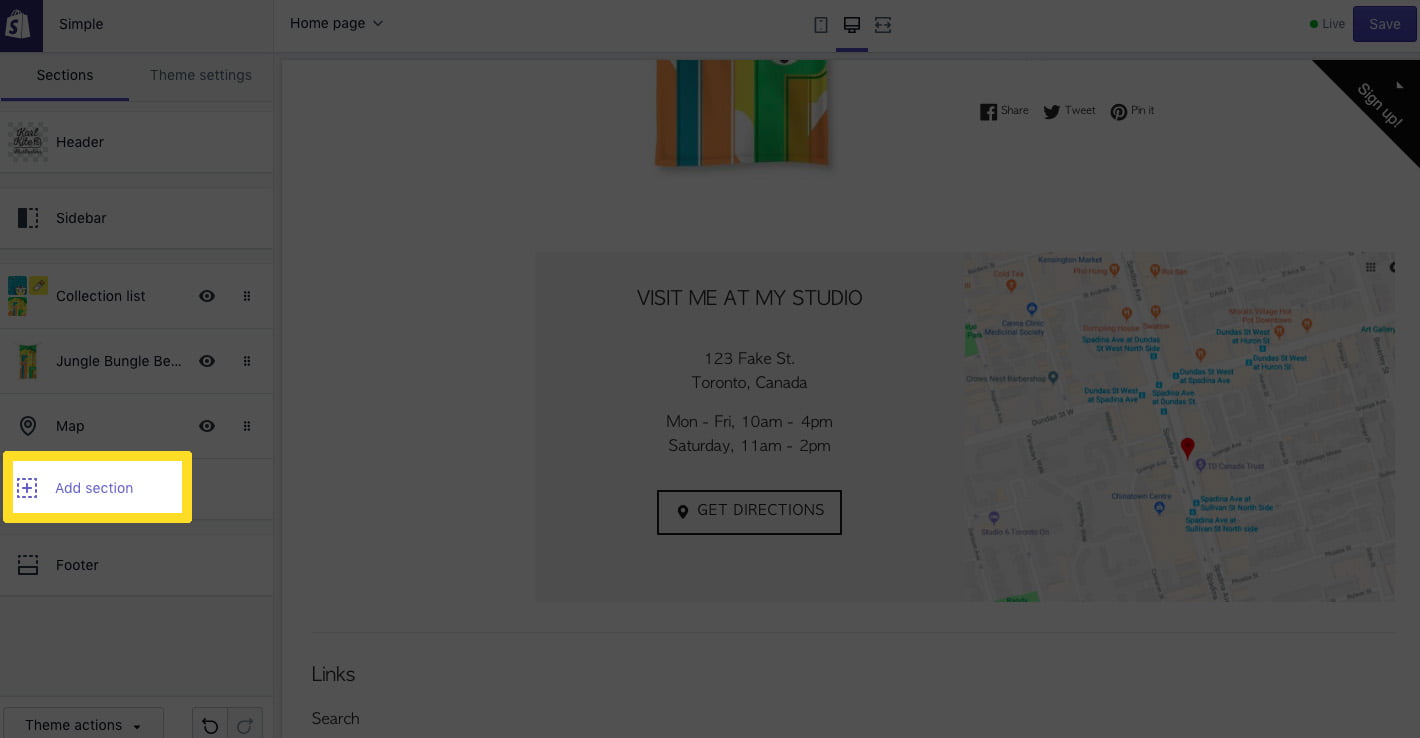

You can edit the wording of your newsletter offering if necessary, but the default text looks just fine, too.
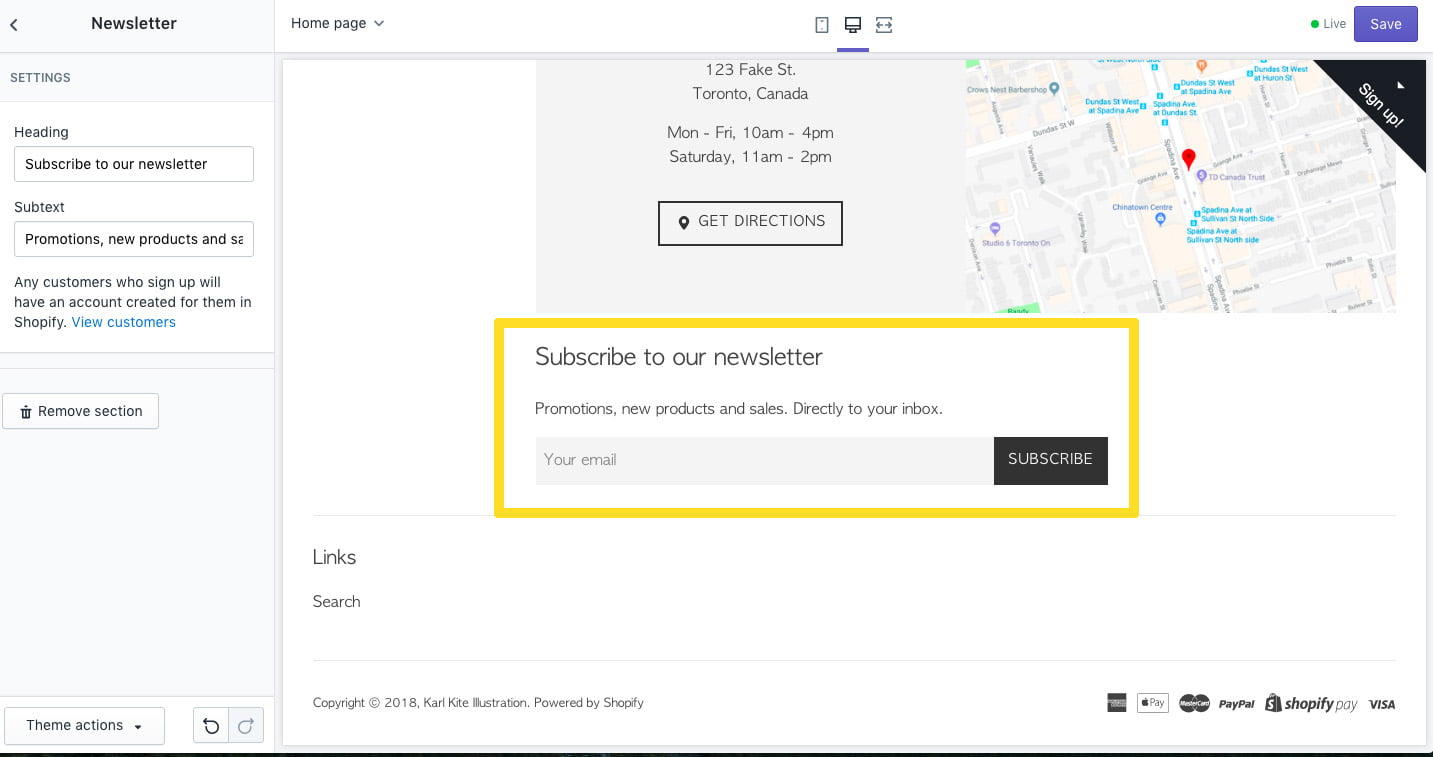
When someone signs up for your newsletter, you can find their email address which is added to your customer list. Just select the Customers section on the left side of your Shopify admin. You can use the Filters to highlight customers who 'Accept email marketing,' as seen below.
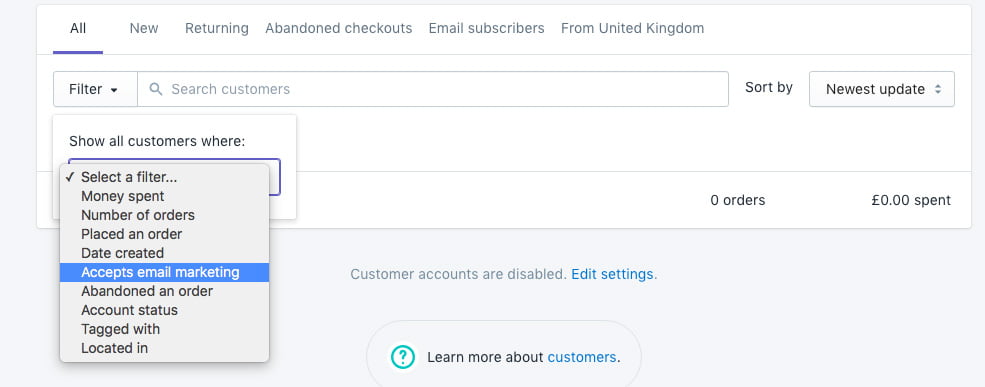
In BigCommerce, it's even easier to set-up. Head to your dashboard, and click 'Marketing.' Select 'Email Marketing' then make sure the 'Yes, allow customers to subscribe to the store newsletter' option is ticked.
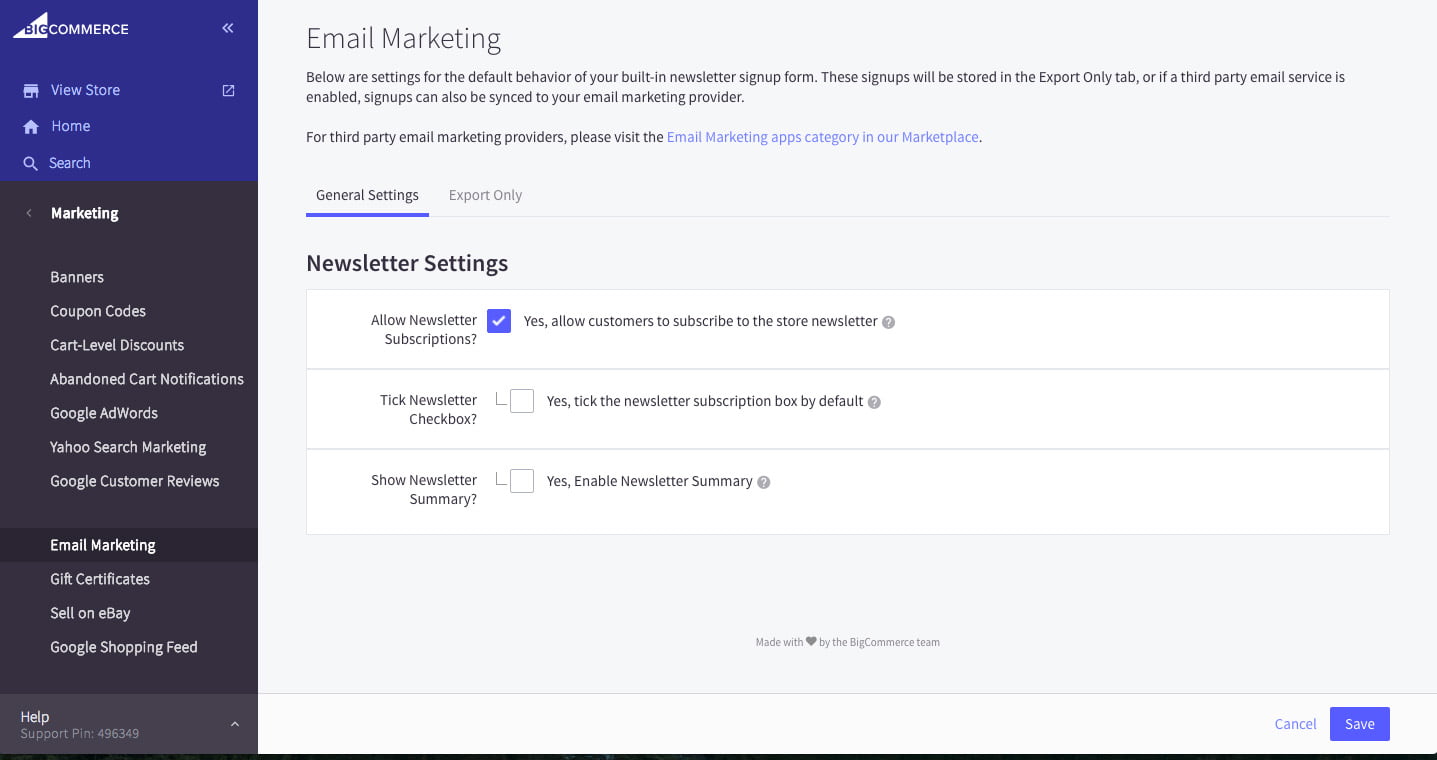
Ticking the 'Yes, Enable Newsletter Summary' option will let you write a description to entice your visitors to sign up.
You can export a full list of your newsletter signups as a CSV file at any time by clicking 'Marketing > Email Marketing > Export Only.'
From there, it's all about engaging them with great newsletter content. In terms of delivering this content, you want to use a third party email service provider. Omnisend is available for both Shopify and BigCommerce — it's free and does all the important stuff you need.
And if you're stuck for inspiration in terms of what to include, you'll find some great inspiration here.
Discounts, Promotions & Offers
“Join our mailing list and we'll give you 15% off your next order.”
“Sign up for offers and get free shipping next time you buy!”
We've all seen this kind of offer, and there's no doubt that they can be very appealing. Again, the logic is — you may not be ready to buy today — but give us your email address and, when you ARE ready to buy, you'll get a tasty discount as a reward.
In order to administer these kinds of discounts, try installing an app like Privy. Again, it's available for both Shopify and BigCommerce. It's a bit fiddly to get used to, but once you know what you're doing, you'll see that it's a really powerful tool. It lets you set up discounts, promotions and offers that are perfect for capturing emails and therefore generating leads.
From your Privy dashboard, hit 'New Campaign.'
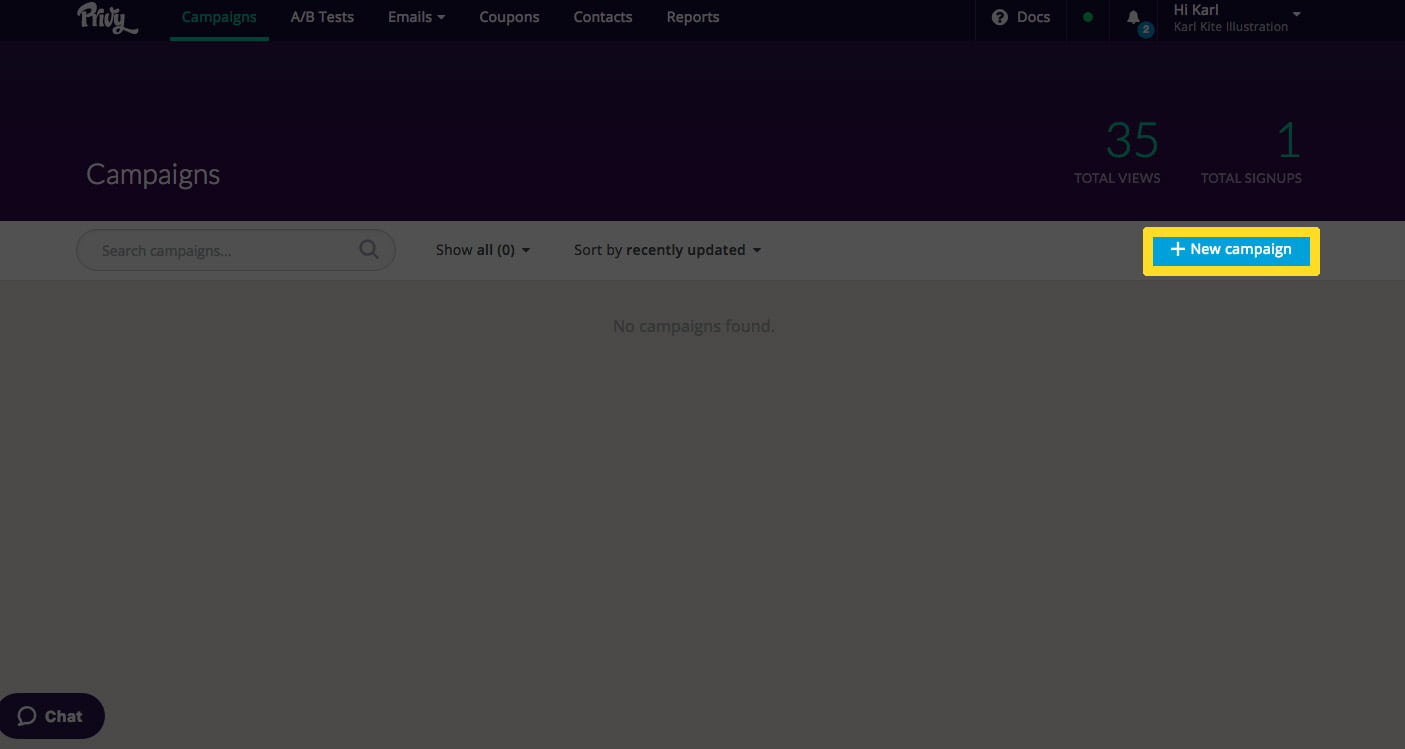
There are a variety of different types of campaigns to set up. For example, a Welcome Discount can be a nice way to entice first-time visitors to place their first order. Exit Email Capture campaigns recognise behaviour that suggests the visitor is about to bounce and shows a popover to re-engage them. Or alternatively you might choose to just Build Your Own.

For the purpose of our example, we'll set up an 'Exit Email Capture' campaign. We want to have it triggered to show when it detects 'exit intent', we only want it to trigger once per day, and only for customers who haven't yet signed up.
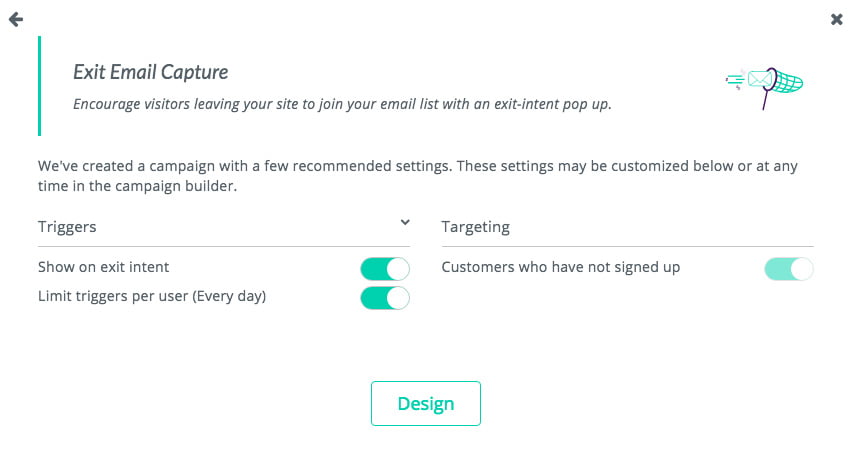
Now, we can design our campaign. Again, we're given some pretty basic design and text placeholders which we can edit and tweak to make it as engaging as possible.
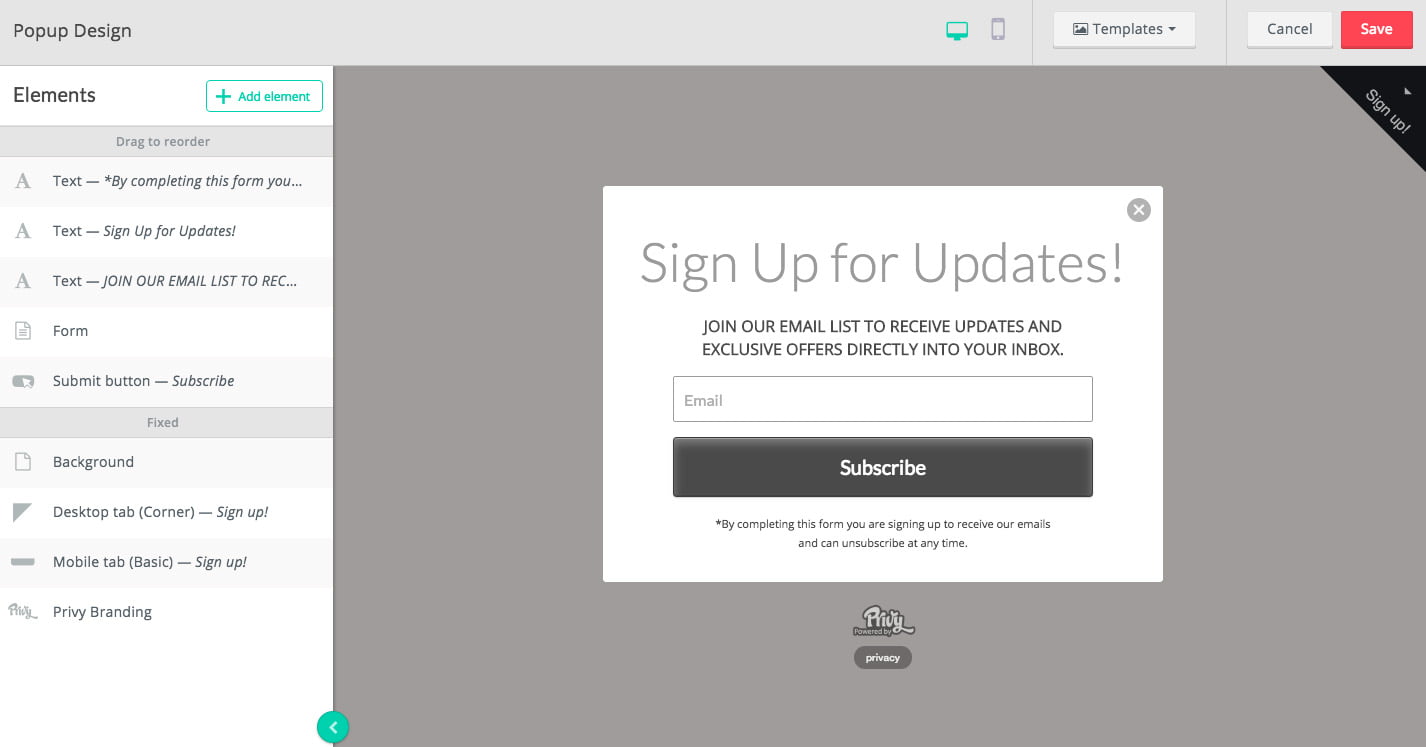
Now, let's assume we're giving our email signups a discount — we'll say it's 15%. We'll include that information within our copy to make the offer as enticing and clear as possible.
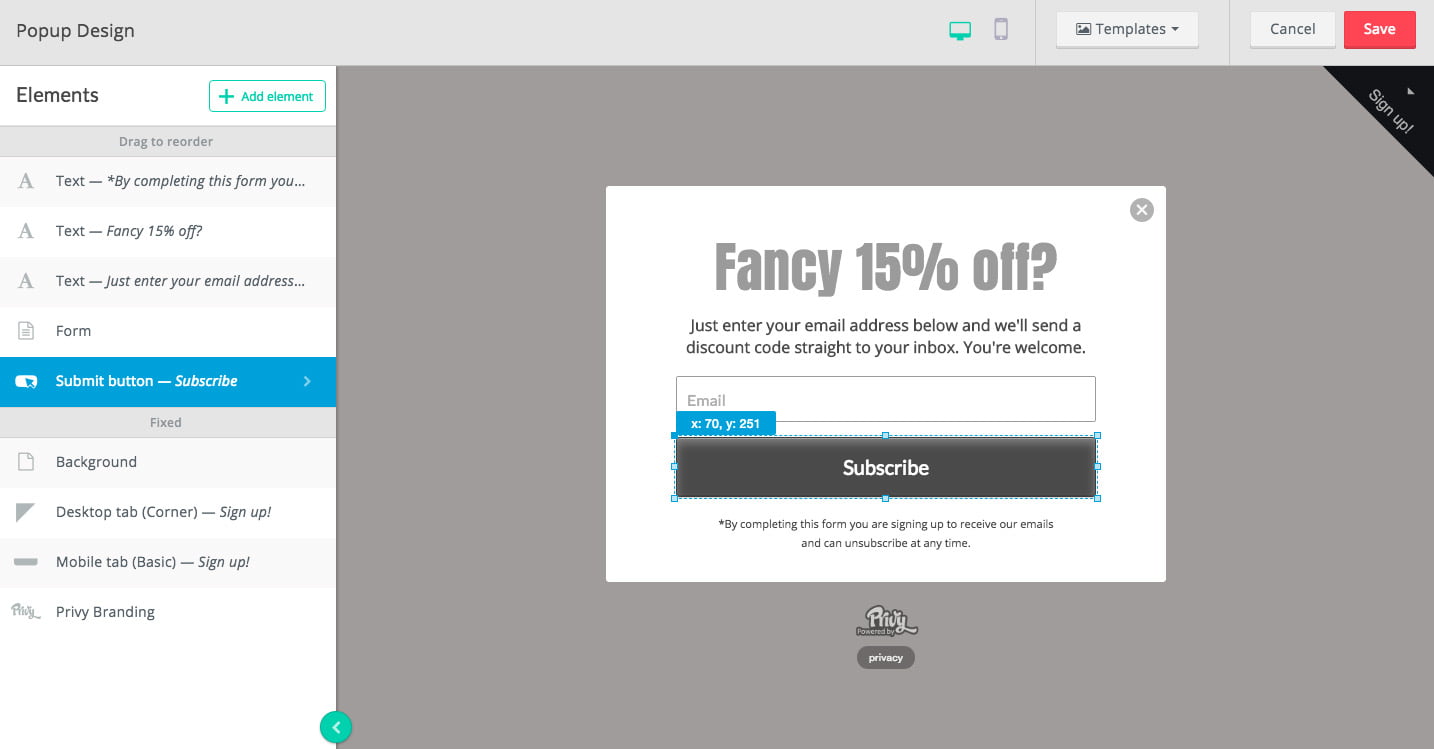
Now, we need to save and 'launch' the campaign. There are more options available after this step.
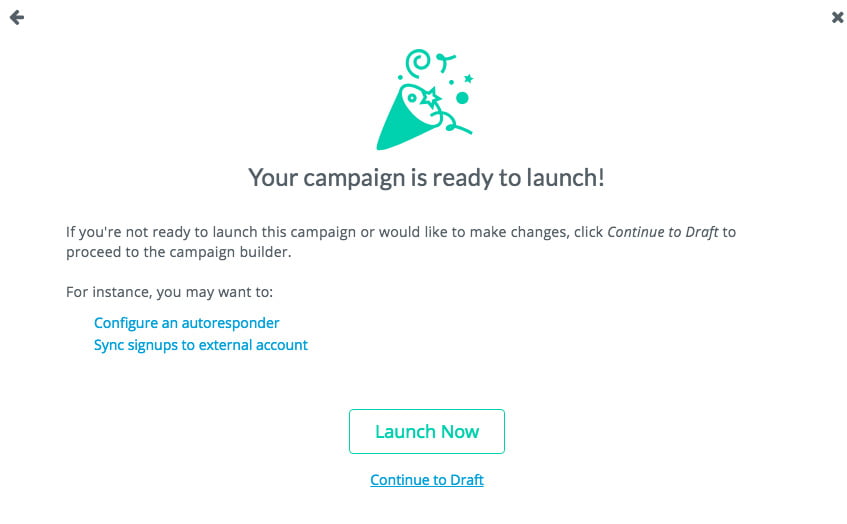
Once it's launched, we can use the options highlighted below to edit all sorts of elements of our campaign including the form components, design, behaviour, emails, automation — and the all-important results.
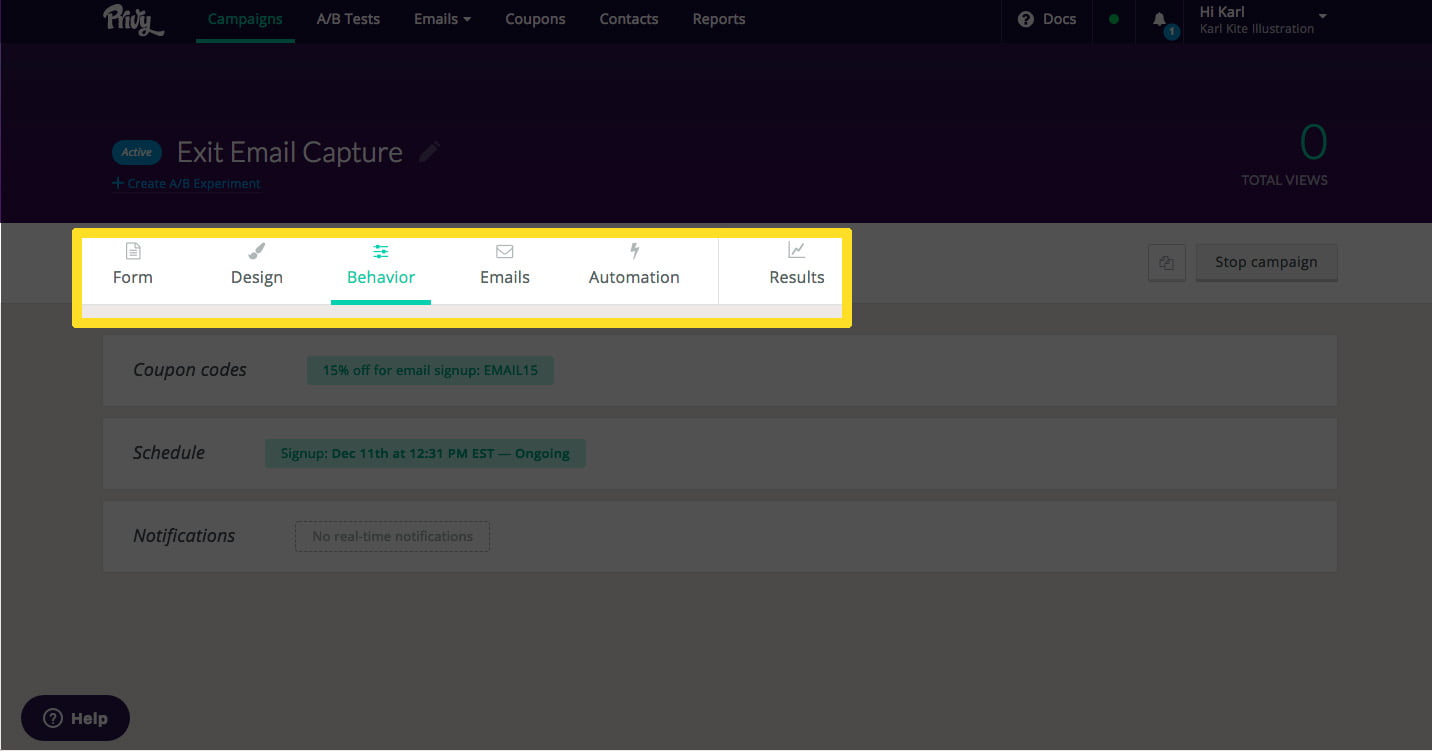
Clicking into the 'Behavior' tab is where you can set up your introductory discount. Edit the 'Coupon codes' field and you'll be able to choose which code to add. If you don't have any coupons setup, you can access the 'Coupons tab' by clicking the link.

Using Privy's free plan, you can set up one catch-all code to apply for all your customers. However, if you upgrade to a paid plan, you'll be able to send a different code to each of your new sign ups, avoiding reuse and abuse.
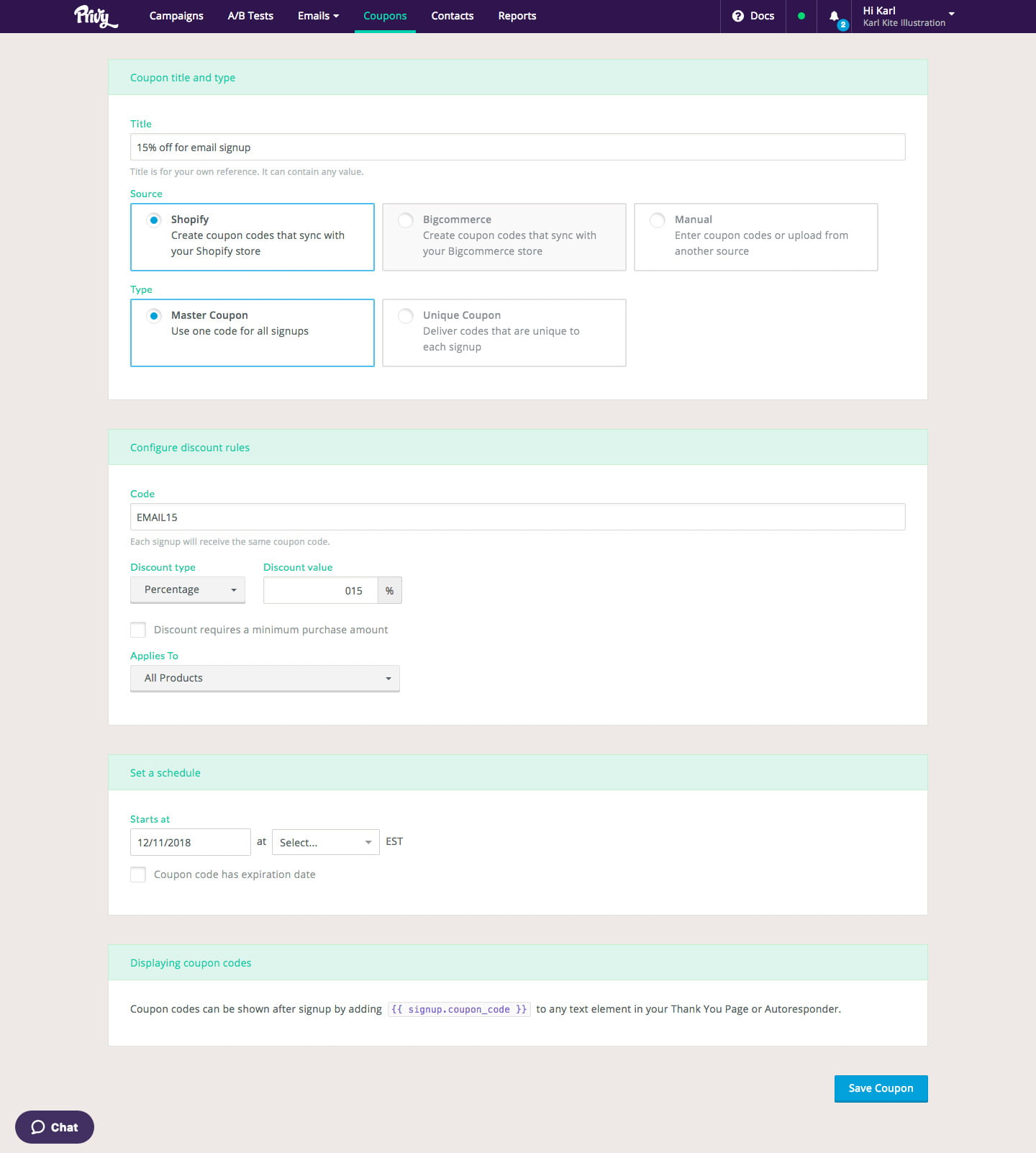
Your new coupon will appear in the drop-down menu for selection.

You can preview and edit the email your new signups will receive, and send a test email to your own account.
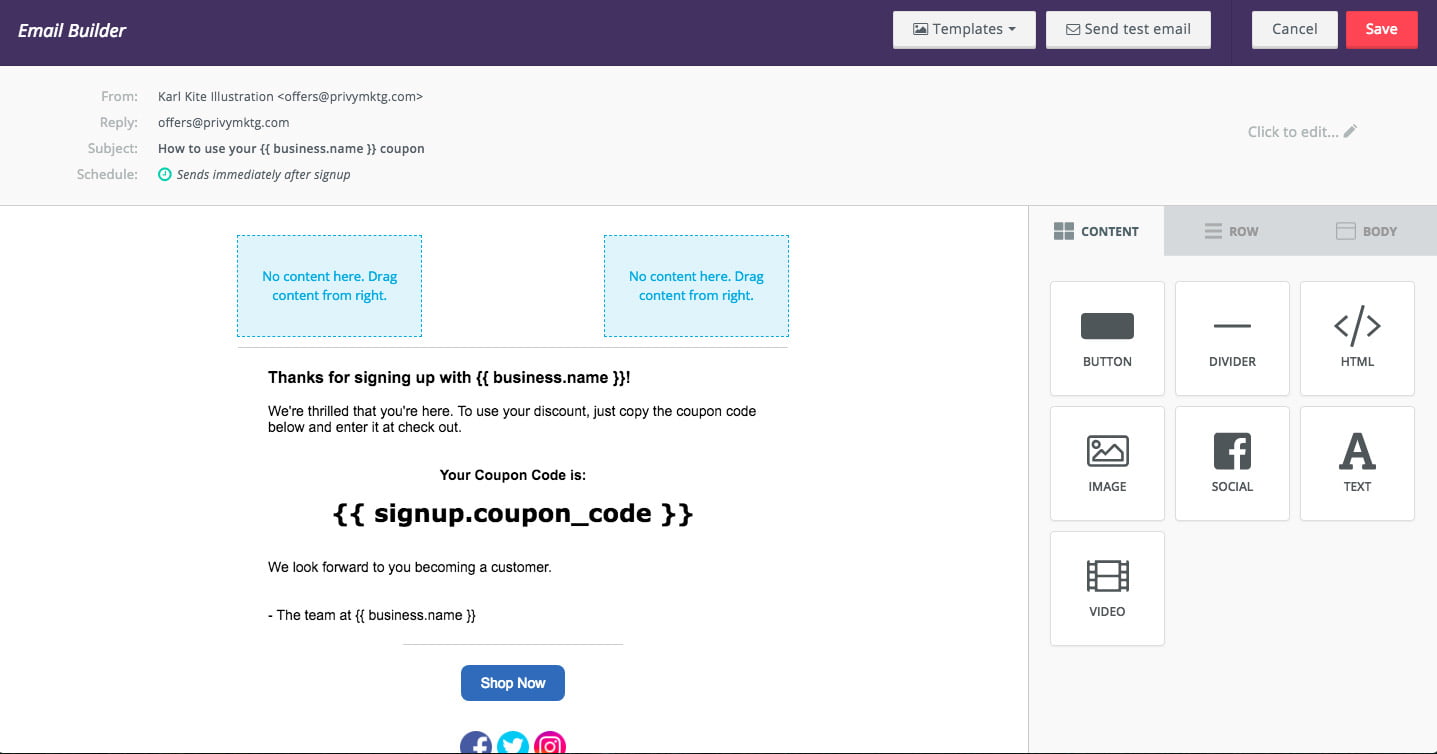
Remember to hit 'Save' after making any changes to ensure they're applied to your campaign. And once you've followed all these steps — you have a compelling 'popover' campaign designed to capture email addresses, and offering something in return.
Spin to Win
That's not the end of what you can do with these email capture popovers. One trend which is seeing increased popularity at the moment is the 'spin to win' lead capture technique. Here, Privy will detect exit intent and display a sort of 'wheel of fortune' for the viewer to play. Of course — they have to enter their email address in order to spin it.
So, the example below comes from DMC Watches — a watch manufacturer, inspired by the famous Delorean Motor Company car immortalised in the Back to the Future movies.
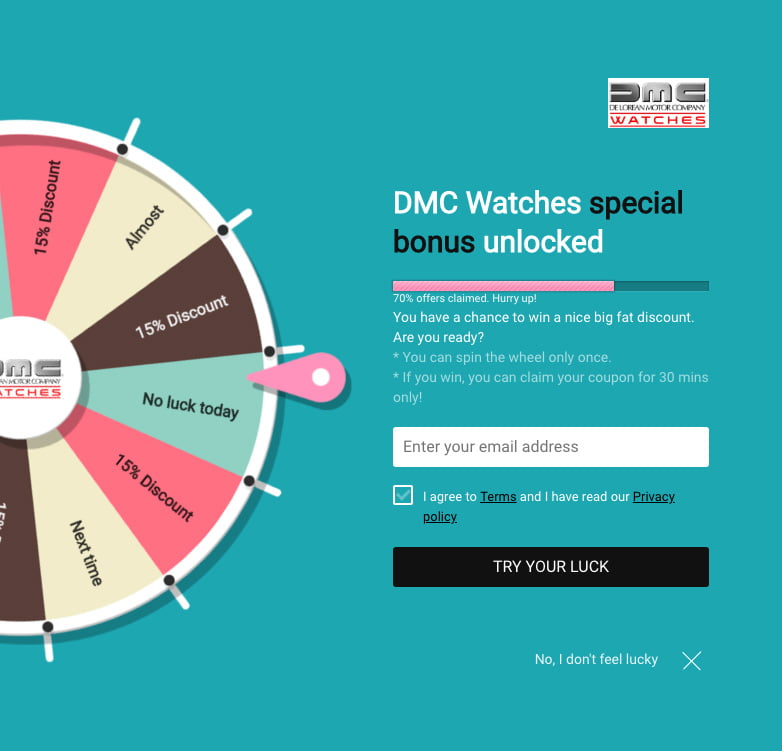
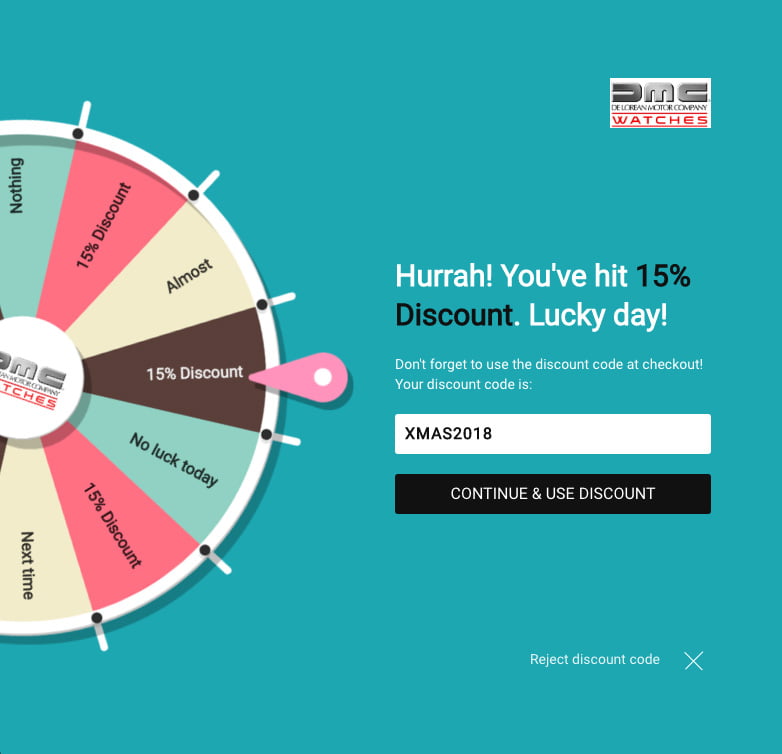
There's a double benefit here — obviously, there's an element of lead gen. But the discount, should the customer be lucky enough to spin one, is also a helping hand pushing them towards purchase. Either way — we're converting those anonymous visitors into either leads or customers. To set up this kind of campaign, head to your Privy campaign dashboard and select 'Design > Add a Display.'

Select 'Spin To Win' from the menu on the left-hand side, and then choose your preferred colour scheme.
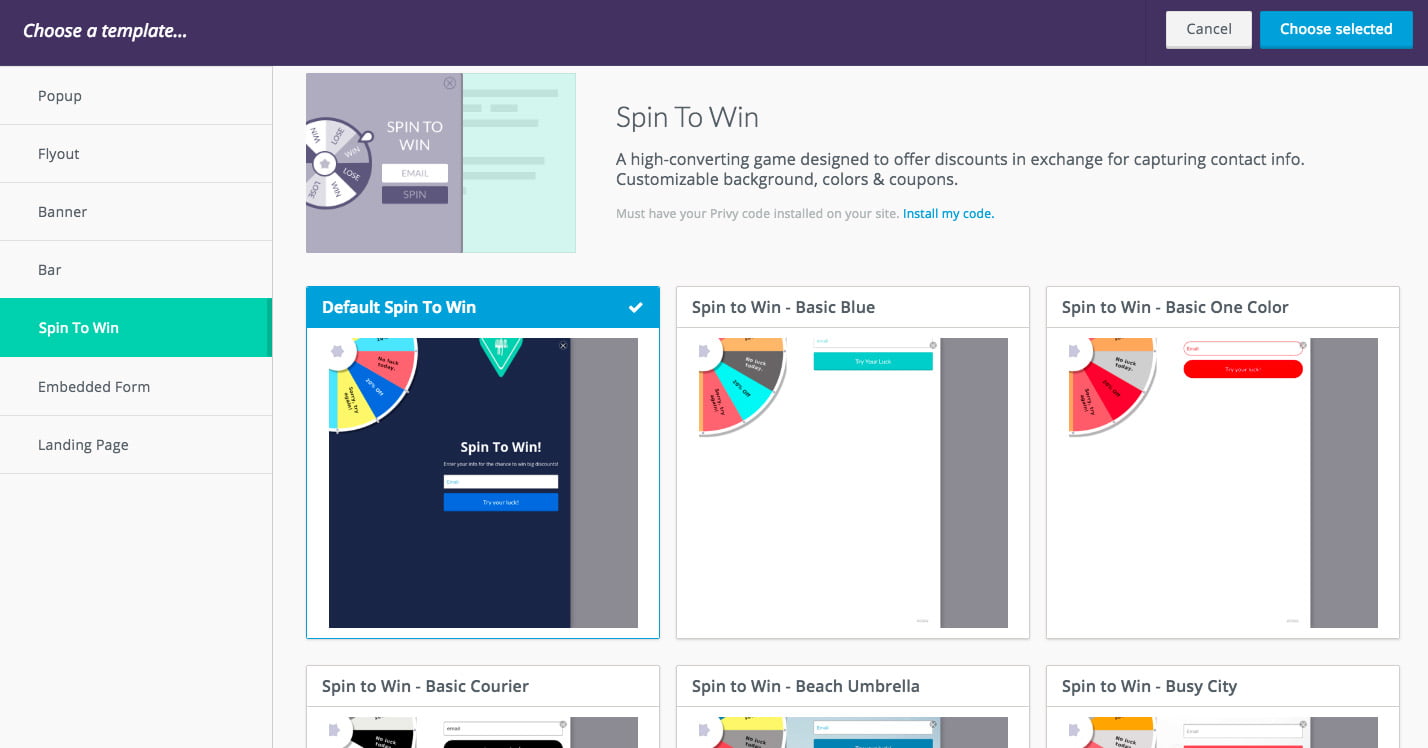
Again, you can use the editor to tweak and refine the messaging…
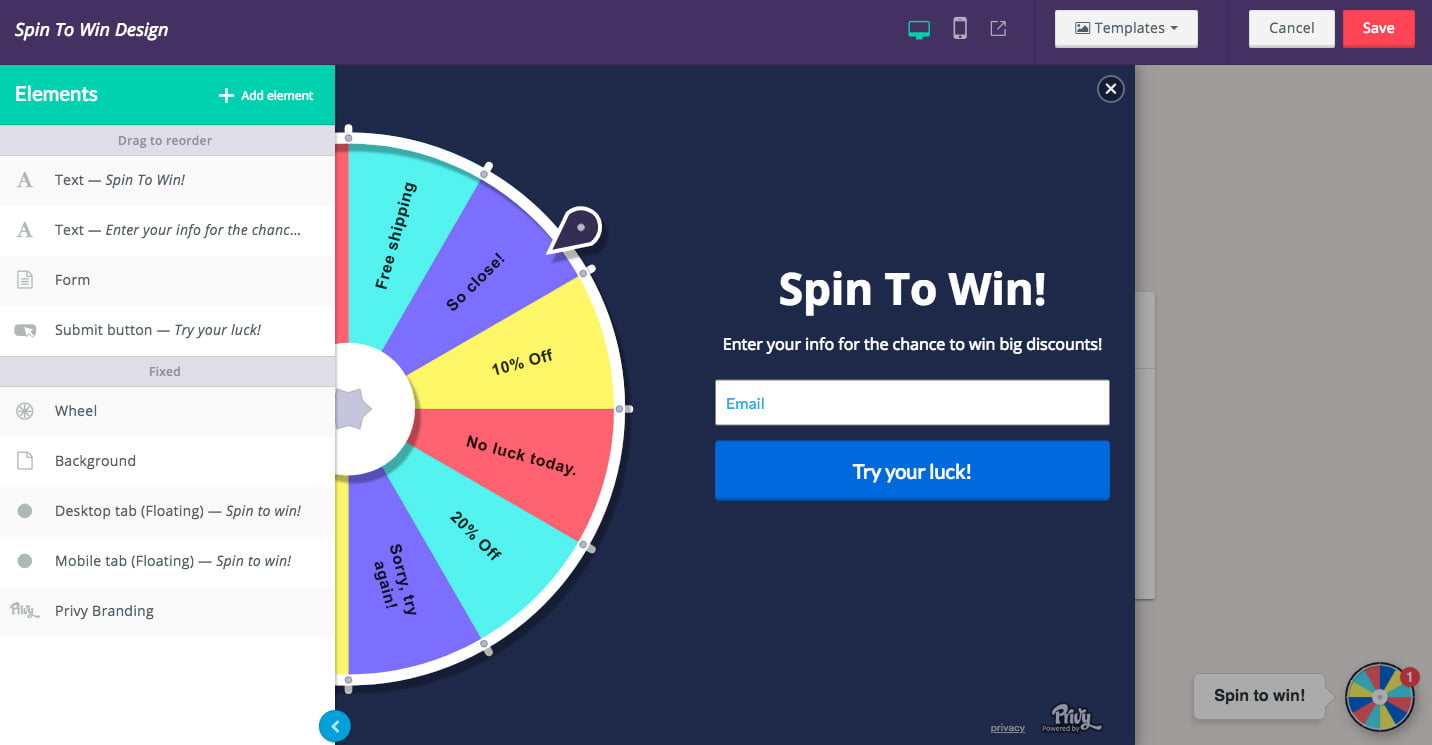
Hit 'Save' and you're all set! Your users will have the opportunity to 'spin the wheel' in exchange for their email address — generating you leads.
Referral Bonuses
While 'converting' anonymous traffic is understandably the focus for many ecommerce sellers looking to improve lead gen — driving better quality traffic is always a healthy step. This is a whole other layer of lead gen. Why? Because a lot of the steps you can take to encourage your visitors to sign up will also help persuade others.
People discuss the things they buy with their friends and family. If your customers can tell their friends and family they can get a 15% discount, say, for signing up to the newsletter through your store — that could bring them onto your website looking to hand over their info. This can help amplify the reach of your brand, bringing more traffic, and, yes, more leads.
You could, technically, run a manual referral scheme by creating Coupon or Discount codes in BigCommerce or Shopify. But to run it at scale, that's going to be impractical if not impossible.
A good solution is to consider using a free app like Swell, which is available for Shopify and BigCommerce. Swell essentially allows you to have a 'points' based scheme, where particular positive behaviours earn points. So, signing up to the newsletter might be worth 200 points, spending might be worth 10 points for every £1 spent — and referring to a friend or family member might be worth 400 points, for both the customer and the person they refer. This gives them both an incentive, and drives profitable behaviours in your store.

Gated Content
For a variety of reasons, content has become one of the web's foremost marketing tools. Businesses and individuals in all sorts of different niches use content to help them engage customers and achieve business goals. The idea is to build a relationship with your audience by adding real value to them.
Much of this content is publicly available — things like blog articles and YouTube videos. While this sort of content is incredibly important, there's another type of exclusive content which requires your user to take some action before they can access it. It's kind of like being hidden behind a 'gate' — hence the name 'gated content.' What opens the gate? Typically, your email address!
This is content that's really valuable, really enticing, to the point that your customer will have no problem whatsoever handing over their email address in exchange for viewing it.
In the B2B space, gated content usually refers to downloadable, comprehensive content like ebooks and white papers. This can be the case in ecommerce too. If you're selling to foodies, you could create recipe books. If your audience is packed with fashionistas, create comprehensive style guides — think 101 Must-Have Looks for Winter.
But there's other ways to gate content, too — using Wistia's Turnstile tool, for example, you can gate video content.

Plan B: Retargeting
Can't part your visitors from their email address? It's not the end of the world!
Your Plan B is retargeting. Ever been on an ecommerce website, umming and ahhing about whether to buy the shoes? You decide against it — only to see those same shoes advertised to you again and again for days, teasing and tantalising you until you're powerless to resist, and head back to buy them?
That's retargeting. You didn't hand over any contact details, but the in-built code of the store website recognised you and used your cookies to advertise to you elsewhere on the web.
Thanks for Reading!
It's hard to exaggerate how significant lead gen can be in your overall ecommerce marketing efforts.
Remember — that benchmark for ecommerce conversion is 1.33%. Don't let the remaining 98.67% get left behind!
The tactics outlined in this article are simple, powerful and effective. And by growing your email list, you'll have the tools you need to make sure that the first visit isn't the last one!
Good luck!
Looking to acquire leads to sell print on demand products? Check out our Shopify App.

